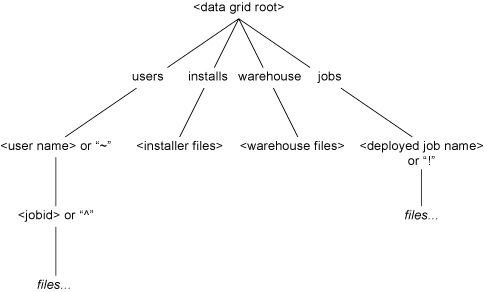3.1 Defining the Datagrid
Within the Orchestrator environment, the datagrid has three primary functions:
3.1.1 Naming Orchestrator Job Files
The Orchestrator datagrid provides a file naming convention that is used by the job JDL code and by the Orchestrator CLI for accessing files created by the grid job. The naming convention is in the form of a URL. For more information, see Section 2.1.4, Jobs.
The datagrid server defines the root of the namespace, with further divisions under the root as illustrated in the figure below:
Figure 3-1 File Structure of Data Nodes in a Datagrid

The grid URL naming convention is the form grid://<gridID>/<file path>. Including the gridID is optional and its absence means the host default grid.When writing jobs and configuring a datagrid, entering the symbol ^ can be used as a shortcut to the <jobid> directory either standalone, indicating the current job, or followed by the jobid number to identify a particular job.Likewise, the symbol ! can be used as a shortcut to the deployed jobs’ home directory either standalone, indicating the current jobs’ type, or followed by the deployed jobs’ name.The symbol ~ is also a shortcut to the user’s home directory in the datagrid, either by itself, indicating the current user, or followed by the desired user ID to identify a particular user.
The following examples show address locations in the datagrid using the ZOS command line tool. These examples assume you have logged in using “zos login” to the Orchestrator Server Server you are using:
Directory Listing of the Datagrid Root Example
$ zos dir grid:///
<DIR> Jun-26-2007 9:42 installs
<DIR> Jun-26-2007 9:42 jobs
<DIR> Jun-26-2007 14:26 users
<DIR> Jun-26-2007 9:42 vms
<DIR> Jun-26-2007 10:09 warehouse
Directory Listing of the Jobs Subdirectory Example
This example displays all the jobs that are deployed with the Virtual Machine Management (VMM) pack. The jobs listing is different in the High performance Computing (HPC) pack.
$ zos dir grid:///jobs
<DIR> Jun-26-2007 9:42 cpuInfo
<DIR> Jun-26-2007 9:42 findApps
<DIR> Jun-26-2007 9:42 osInfo
<DIR> Jun-26-2007 9:42 vcenter
<DIR> Jun-26-2007 9:42 vmHostVncConfig
<DIR> Jun-26-2007 9:42 vmprep
<DIR> Jun-26-2007 9:42 vmserver
<DIR> Jun-26-2007 9:42 vmserverDiscovery
<DIR> Jun-26-2007 9:42 xen30
<DIR> Jun-26-2007 9:42 xenDiscovery
<DIR> Jun-26-2007 9:42 xenVerifier
3.1.2 Distributing Files
The Orchestrator datagrid provides a way to distribute files in the absence of a distributed file system. This is an integrated service of the Orchestrator that performs system-wide file delivery and management.
3.1.3 Simultaneous Multicasting to Multiple Receivers
The datagrid provides a multicast distribution mechanism that can efficiently distribute large files simultaneously to multiple receivers. This is useful even when a distributed file system is present. For more information, see Section 3.2, Datagrid Communications.
3.1.4 Orchestrator Data Grid Commands
The following data grid commands can be used when creating job files. To see where these commands are applied in the Novell Orchestrator console, see Typical Use of the Grid
.